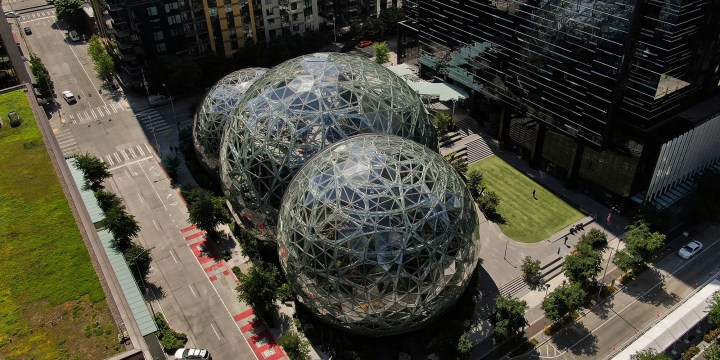CLIMATE CRISIS ROUND-UP
Amazon says its planet-warming carbon emissions grew 18% in 2021

The climate crisis is being felt and dealt with in various ways worldwide. In these climate briefs, we aim to give a round-up of the latest developments and news from across the globe.
Amazon said its carbon footprint grew 18% in 2021, as the company’s rapid growth during the pandemic overwhelmed nascent efforts to cut its contribution to the emissions warming the planet.
The world’s largest online retailer emitted 71.54 million metric tons of carbon-dioxide equivalent last year, Amazon disclosed on Monday in an updated edition of its sustainability report. That’s up about 40% since the company first disclosed the figure, with data from 2019.
Amazon’s carbon intensity — a measure that divides its emissions by gross merchandise sales — fell 1.9%, an indication of the company’s success in delivering products and running its warehouses, data centres and offices more efficiently.
Amazon aims to become a “net zero” emitter of greenhouse gases by 2040.
Besides cutting emissions with electric vehicles and other operational initiatives, Amazon plans to buy credits linked to projects that remove carbon from the atmosphere. The net zero pledge presents a huge challenge for a company that seeks to grow like a startup and operates a cargo airline, a sprawling retail and logistics business, grocery stores and data centres.
Amazon’s accounting of its carbon footprint includes emissions generated by its own offices and data centres, purchased electricity, tailpipe emissions from delivery partners and the manufacturing of Amazon-branded products, among other factors. In contrast to some retailers, the Seattle company doesn’t attempt to account for the emissions that go into the manufacture of products it sells, except private-label merchandise.
“The challenges we collectively face on the path to net-zero carbon are considerable,” Amazon said in its report. “Many new technologies are showing promise in their ability to reduce carbon emissions, but may still require significant development.” — Bloomberg
England records driest July in 87 years amid sizzling heat wave
England had the driest July since 1935 amid a searing heat wave that pushed infrastructure to the brink and severely disrupted travel.
The unusually dry weather came as temperatures rose above 40°C for the first time. The intense heat had sparked fires near London, triggered warnings that railway lines could buckle, cancelled flights and forced power stations to operate at low levels to prevent overheating.
The dry and hot summer spreading across all of Europe is also a stark reminder of the unfolding climate crisis. Heat waves are becoming more frequent and intense, and temperatures this extreme are set to become more common.
A high-pressure weather system dominated the UK last month, pushing most of the rain toward the northwest of the country, according to the Met Office. Rainfall was also more uneven than usual, with England registering just 35% of its average rainfall for July, according to the statement.
Southern England reported its driest July on record, based on the weather provider’s data going back to 1836, with just 17% of the average rainfall for the period.
The UK as a whole recorded its driest month in 20 years, with just 56% of the average rain for the month. — Bloomberg
MyHydro offers green power to Congo with California turbines
An Africa-focused hydro-power startup has teamed up with a Californian maker of “fish-safe” turbines in a bid to solve electricity supply problems in Democratic Republic of the Congo.
MyHydro has signed a memorandum of understanding with the Congolese government to develop 36 small hydro projects in a country where only about 10% of its 100 million people have access to electricity. The plants will use turbines made by Natel Energy, which have blunted blades that leave almost all the fish that pass through the turbines unharmed.
The New York-based company is banking on the technology to provide a constant stream of energy that’s more reliable than solar alternatives. The turbines are to be installed in rivers rather than requiring the construction of reservoirs and the company says their low impact on ecosystems will allow it to attract investment to expand across Africa.
Congo has 13% of the world’s hydropower potential, according to the African Development Bank, yet the industry is barely developed. It’s also home to the Congo River, the world’s second-biggest by volume after the Amazon. While plans have been mooted to build power plants on the river, the so-called Grand Inga project that could produce tens of thousands of megawatts, they haven’t come to fruition.
Visit Daily Maverick’s home page for more news, analysis and investigations
“We went to Congo because the need there with these big cities with no power is enormous,” founder Paul Hinks, who is also the head of power producer Symbion Power, said in an interview. “The hydrology is the best in Africa.”
Anser, Congo’s electrification agency, didn’t respond to requests for comment. — Bloomberg
Zimbabwe eyes more solar water heaters as power grid struggles
People in Zimbabwe are used to taking cold baths during lengthy power cuts, but Cosmas Ndlovu’s new home means his family are among the fortunate few who can enjoy hot water at all hours.
When the 48-year-old built his house in the southern African nation three years ago, he had to include a rooftop solar water heater to comply with a 2019 law that banned the installation of electric heaters in buildings.
While the father-of-five said the 150-litre-capacity heater — which directly absorbs the sun’s warmth to heat water — was expensive, at the equivalent of about $410, he believed it had proved a worthwhile investment.
“Once the water is heated in the solar geyser, it takes two days before it cools down,” Ndlovu told the Thomson Reuters Foundation at his home in the Pelandaba West district, a newly established suburb not yet connected to the grid.
“Warm water never runs out. I can have a hot bath even in the middle of the night,” said Ndlovu, who has installed three solar panels to power his lights, television, stove and refrigerator.
As Zimbabwe’s grid struggles with increased electricity demand, the government is emphasising the need for renewable energy and thermal solar water heaters in homes and buildings.
Zimbabwe has in the past endured severe electricity blackouts that last up to 18 hours as a result of drought reducing dam levels at its main hydropower plant, and breakdowns of coal-fired generators.
While Zimbabwe is on a drive to boost solar power to cut electricity import costs and combat climate change, renewable suppliers, energy experts and builders warn that the expense of putting such systems into place is a barrier to their use.
Lawrence Mashungu, a climate change expert at the ministry of environment, water and climate, said the government was not offering funds for people to install solar heaters, but “was providing advice” about their cost-saving merits.
Zimbabwe’s Secretary for Energy, Gloria Magombo, said the government was considering subsidies for new housing developments that adopt solar water heaters as well as a programme that would see banks provide loans to install them.
“Already, most new housing developments have adopted solar water heaters, which is very positive,” she said in an interview.
The nation has a target of installing at least 250,000 solar water heaters in old and new buildings by 2030. The government said it had no data on how many were in place.
Under the 2019 law, new buildings that do not have solar water heaters cannot be connected to the grid, and offenders can face a fine and up to a year in prison. — Reuters
Rich countries failed to meet their climate funding goal
Rich nations failed to meet a long-standing pledge to deliver $100-billion to help poorer countries cope with climate change, the Organisation for Economic Co-operation and Development (OECD) said.
Back in 2009, developed countries promised that by 2020 they would transfer $100-billion per year to vulnerable states hit by increasingly severe climate-linked impacts and disasters.
In fact, they provided $83.3-billion in 2020 — falling $16.7-billion short of the target, the OECD said.
The missed goal is no surprise. The OECD uses UN data processed with a two-year delay, and rich countries have already signalled the target would not be met until 2023.
But it is a blow ahead of COP27, the United Nations’ annual climate summit in November, where countries will face pressure to cut CO2 emissions faster.
Finance has become a sore point in these talks, and developing economies say they cannot afford to curb pollution without support from the rich nations responsible for most of the CO2 emissions heating the planet.
“Honouring that commitment is central to renew trust,” said Yamide Dagnet, Climate Justice Director at the Open Society Foundation, though she said $100-billion is a fraction of vulnerable states’ actual needs.
“We need developed countries to present credible plans to escalate their climate finance,” Dagnet said.
The OECD does not break down the data by individual countries. It said it was not clear how the Covid-induced economic slump may have hit countries’ contributions, which include public loans, grants and private investments that public bodies helped mobilise.
In recent years, the European Union and its 27 member countries have collectively been the biggest climate finance provider.
As crop-shrivelling droughts, rising sea levels and deadly heat batter the world’s poorest nations, they are also demanding compensation for these escalating climate-linked losses.
The United States, EU and other big polluters have so far resisted steps that could lead to such payments — but some officials said positions were beginning to shift.
“I believe a Loss and Damage Funding Facility is gaining traction,” said Carlos Fuller, Belize’s ambassador to the United Nations.
“We now need to work on those developed countries who remain hesitant,” he said. — Reuters/DM/OBP





















 Become an Insider
Become an Insider
Comments - Please login in order to comment.